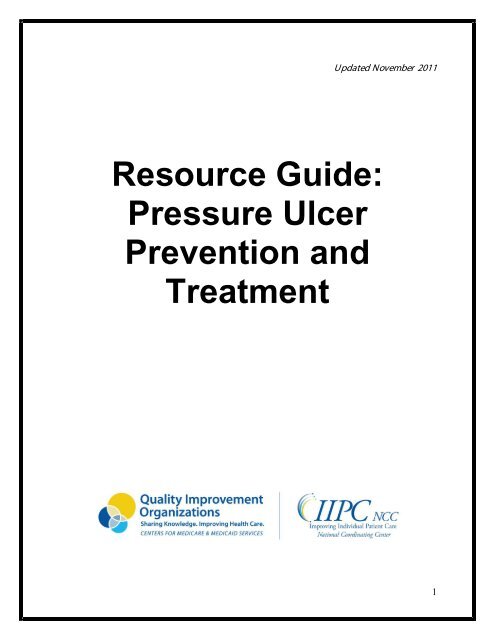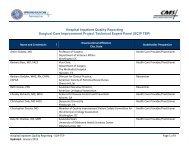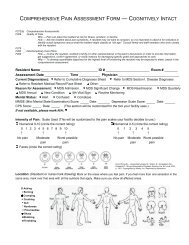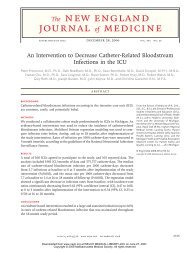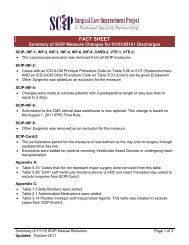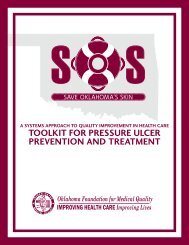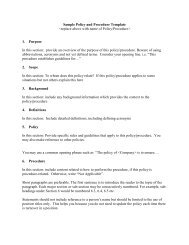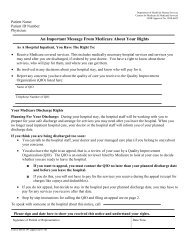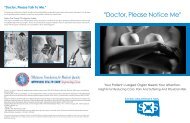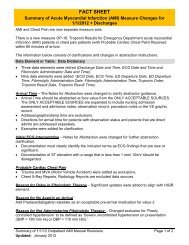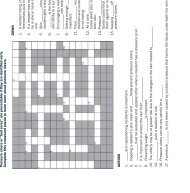Resource Guide: Pressure Ulcer Prevention and ... - HealthInsight
Resource Guide: Pressure Ulcer Prevention and ... - HealthInsight
Resource Guide: Pressure Ulcer Prevention and ... - HealthInsight
Create successful ePaper yourself
Turn your PDF publications into a flip-book with our unique Google optimized e-Paper software.
Updated November 2011<br />
<strong>Resource</strong> <strong>Guide</strong>:<br />
<strong>Pressure</strong> <strong>Ulcer</strong><br />
<strong>Prevention</strong> <strong>and</strong><br />
Treatment<br />
1
TABLE OF CONTENTS<br />
TABLE OF CONTENTS ............................................................................................................................................ 2<br />
PURPOSE .................................................................................................................................................................... 3<br />
INTRODUCTION ....................................................................................................................................................... 4<br />
DEFINITIONS ............................................................................................................................................................. 6<br />
PRESSURE ULCER PREVENTION STRATEGIES.............................................................................................. 8<br />
IDENTIFICATION AND TRACKING OF PRESSURE ULCERS ..................................................................... 10<br />
ASSESSMENT AND DOCUMENTATION OF PRESSURE ULCERS .............................................................. 11<br />
PRESSURE ULCER TREATMENT STRATEGIES ............................................................................................ 13<br />
INDIVIDUALIZED CARE....................................................................................................................................... 14<br />
ADDITIONAL RESOURCES .................................................................................................................................. 15<br />
2
PURPOSE<br />
This guide is intended to assist Quality Improvement Organizations <strong>and</strong> nursing homes in<br />
reducing the rate of high risk pressure ulcers by providing helpful resources.<br />
This guide is not meant to be an exhaustive list of resources. With the discontinuation of<br />
MedQIC, there is not currently a central location for QIO materials to be posted on the internet.<br />
The NCC searched for existing resources from the QIO community. Some of those resources are<br />
listed here.<br />
3
INTRODUCTION<br />
A pressure ulcer is localized injury to the skin <strong>and</strong>/or underlying tissue usually over a bony<br />
prominence, as a result of pressure, or pressure in combination with shear <strong>and</strong>/or friction<br />
(NPUAP). In addition to being costly (CMS estimates the cost of treating just one Stage III or IV<br />
pressure ulcer is $43,180 1 ), pressure ulcers are serious medical conditions <strong>and</strong> one of the<br />
important measures of the quality of clinical care in nursing homes. <strong>Pressure</strong> ulcers can be<br />
dangerous <strong>and</strong> painful for a resident, in part because broken skin can allow infection into the<br />
body. If untreated, pressure ulcers can deepen <strong>and</strong> even expose the bone. Deeper ulcers may be<br />
hard to heal or may not heal at all. Sometimes, pressure ulcers can lead to death. The presence of<br />
pressure ulcers limits the quality of life for a resident as evidenced by:<br />
• Decrease in bowel <strong>and</strong> bladder function<br />
• More incontinence<br />
• Decrease in ability to move without help<br />
• Decrease in mental capacity<br />
• Increase in pain<br />
• Increased risk for infection<br />
• Less participation in activities (Fact Sheet)<br />
Data from the 2004 National Nursing Home Survey revealed that 2% to 28% of nursing home<br />
residents have pressure ulcers. Other key findings from the 2004 National Nursing Home<br />
Survey 2 :<br />
• About 59,000 current U.S. nursing home residents (11%) had pressure ulcers. Stage 2<br />
pressure ulcers were the most common.<br />
• Residents aged 64 years <strong>and</strong> under were more likely than older residents to have<br />
pressure ulcers.<br />
• Residents of nursing homes for a year or less were more likely to have pressure ulcers<br />
than those with longer stays.<br />
1 Federal Register: Department of Health <strong>and</strong> Human Services Centers for Medicare <strong>and</strong> Medicaid Services Part II,<br />
p. 48473 Tuesday, August 19, 2008.<br />
2 http://www.cdc.gov/nchs/data/databriefs/db14.pdf<br />
4
• One in five nursing home residents with a recent weight loss had pressure ulcers.<br />
• Thirty-five percent of nursing home residents with stage 2 or higher (more severe)<br />
pressure ulcers received special wound care services.<br />
Clinical practice, expert opinions, <strong>and</strong> published literature indicate that most, but not all, pressure<br />
ulcers can be prevented. In 2010, the National <strong>Pressure</strong> <strong>Ulcer</strong> Advisory Panel (NPUAP)<br />
organized a consensus congress to study the issue of avoidable <strong>and</strong> unavoidable pressure ulcers.<br />
The results confirmed that pressure ulcers are unavoidable in certain situations where pressure<br />
cannot be relieved <strong>and</strong> perfusion cannot be improved3.<br />
This guide provides resources to help nursing homes prevent avoidable pressure ulcers, identify<br />
<strong>and</strong> document pressure ulcers, <strong>and</strong> use evidence-based guidelines to care for <strong>and</strong>/or heal pressure<br />
ulcers.<br />
For regulatory guidance on F309, Quality of Care, <strong>and</strong> F 314, <strong>Pressure</strong> Sores, refer to The CMS<br />
Manual System Guidance to Surveyors for Long Term Care Facilities, Appendix PP.<br />
3 http://npuap.org/OWM2011_Black_0.pdf<br />
5
DEFINITIONS<br />
<strong>Pressure</strong> <strong>Ulcer</strong>- A pressure ulcer is localized injury to the skin <strong>and</strong>/or underlying tissue usually<br />
over a bony prominence, as a result of pressure, or pressure in combination with shear <strong>and</strong>/or<br />
friction<br />
Suspected Deep Tissue Injury- Purple or maroon area of discolored intact skin due to damage<br />
of underlying soft tissue damage. The area may be preceded by tissue that is painful, firm,<br />
mushy, boggy, warmer or cooler as compared to adjacent tissue.<br />
Stage 1 <strong>Pressure</strong> <strong>Ulcer</strong>- An observable, pressure-related alteration of intact skin, whose<br />
indicators as compared to an adjacent or opposite area on the body may include changes in one<br />
or more of the following perimeters: skin temperature (warmth or coolness); tissue consistency<br />
(firm or boggy); sensation (pain, itching) <strong>and</strong>/or a defined area of persistent redness in lightly<br />
pigmented skin, where as is darker skin tones, the ulcer may appear with persistent red, blue, or<br />
purple hues.<br />
Stage 2 <strong>Pressure</strong> <strong>Ulcer</strong>- Partial thickness loss of dermis presenting as a shallow open ulcer with<br />
a red pink wound bed, without slough. May also present as an intact or open/ruptured serumfilled<br />
blister.<br />
Stage 3 <strong>Pressure</strong> <strong>Ulcer</strong>-Full thickness tissue loss. Subcutaneous fat may be visible but bone,<br />
tendon or muscle is not exposed. Slough may be present but does not obscure the depth of tissue<br />
loss. May include undermining <strong>and</strong> tunneling.<br />
Stage 4 <strong>Pressure</strong> <strong>Ulcer</strong>-Full thickness tissue loss with exposed bone, tendon or muscle. Slough<br />
or eschar may be present on some parts of the wound bed. Often include undermining <strong>and</strong><br />
tunneling.<br />
Unstageable <strong>Pressure</strong> <strong>Ulcer</strong>- Full thickness tissue loss in which the base of the ulcer is covered<br />
by slough (yellow, tan, gray, green or brown) <strong>and</strong>/or eschar (tan, brown or black) in the wound<br />
bed. Until enough slough <strong>and</strong>/or eschar is removed to expose the base of the wound, the true<br />
depth, <strong>and</strong> therefore stage, cannot be determined. Stable (dry, adherent, intact without erythema<br />
or fluctuance) eschar on the heels serves as “the body’s natural (biological) cover” <strong>and</strong> should<br />
not be removed. (NPUAP 2007)<br />
Healed <strong>Pressure</strong> <strong>Ulcer</strong>- Completely closed, fully epithelialized, covered completely with<br />
epithelial tissue, or resurfaced with new skin, even if the area continues to have some surface<br />
discoloration.<br />
Eschar-dead or devitalized tissue that is hard or soft in texture; usually black, brown, or tan in<br />
color, <strong>and</strong> may appear scab-like. Necrotic tissue <strong>and</strong> eschar are usually firmly adherent to the<br />
base of the wound <strong>and</strong> often the sides/edges of the wound.<br />
Exudate-any fluid that has been force out of the tissues or its capillaries because of<br />
inflammation or injury.<br />
6
Non-Blancheable-Reddened areas of tissue that do not turn white or pale when pressed firmly<br />
with a finger of device.<br />
Shear- is the result of gravity pushing down on a patient's body <strong>and</strong> the resistance between the<br />
patient <strong>and</strong> the chair or bed.<br />
Friction- the force of rubbing two surfaces against one<br />
Dermis-the connective tissue underlying the skin's surface (epidermis)<br />
Epidermis-outer layer of the skin<br />
Slough Tissue-Non-viable yellow, tan, grey, green, or brown or tissue; usually moist, can be<br />
soft, stringy <strong>and</strong> mucinous in texture. Slough may be adherent to the base of the wound or<br />
present in clumps throughout the wound bed.<br />
Maceration- Refers to skin changes seen when moisture is trapped against the skin for a<br />
prolonged period. The skin may soften, wrinkle, <strong>and</strong> turn white.<br />
Excoriation-an abrasion produced by mechanical means (often scratching), usually involving<br />
only the epidermis<br />
Undermining-The destruction of tissue or ulceration extending under the skin edges (margins)<br />
so that the pressure ulcer is larger at its base than at the skin surface<br />
Tunneling-A passage way of tissue destruction under the skin surface that has an opening at the<br />
skin level from the edge of the wound<br />
Sinus Tract-a cavity or channel underlying a wound that involves an area larger than the visible<br />
surface of the wound<br />
Osteomyelitis-an infection of the bone<br />
Granulation Tissue- Red tissue with “cobblestone” or bumpy appearance bleeds easily when<br />
injured.<br />
Epithelial Tissue- New skin that is light pink <strong>and</strong> shiny (even in people with darkly pigmented<br />
skin). In Stage 2 pressure ulcers, epithelial tissue is seen in the center <strong>and</strong> edges of the ulcer. In<br />
full thickness Stage 3 <strong>and</strong> 4 pressure ulcers, epithelial tissue advances from the edges of the<br />
wound<br />
7
PRESSURE ULCER PREVENTION STRATEGIES<br />
The prevention of pressure ulcers requires strategies that include educational programs directed<br />
at all levels of health care providers, residents, <strong>and</strong> families Fact Sheet (NPUAP)<br />
<strong>Resource</strong> for educational program:<br />
• “Meet Me at the Skin Care Fair” presentation (Louisiana Health Care Review, Inc.)<br />
<strong>Pressure</strong> ulcer prevention strategies should also include assessing the resident:<br />
1. Risk for developing pressure ulcer<br />
2. Skin condition<br />
3. Nutritional status<br />
4. Mechanical loading <strong>and</strong> support surfaces Fact Sheet (NPUAP)<br />
<strong>Pressure</strong> ulcer prevention strategies resources <strong>and</strong> tools:<br />
• <strong>Pressure</strong> <strong>Ulcer</strong> <strong>Prevention</strong> Points: Fact Sheet (NPUAP)<br />
• Interventions Table: <strong>Pressure</strong> <strong>Ulcer</strong>s (Advancing Excellence in America’s Nursing<br />
Homes Campaign)<br />
• Fact sheet for consumers (Advancing Excellence in America’s Nursing Homes<br />
Campaign)<br />
• Fact sheet for nursing home staff members (Advancing Excellence in America’s<br />
Nursing Homes Campaign)<br />
• Reducing <strong>Pressure</strong> <strong>Ulcer</strong>s in Nursing Homes: An Interdisciplinary Process<br />
Framework PowerPoint Presentation (Advancing Excellence in America’s Nursing<br />
Homes Campaign)<br />
• <strong>Prevention</strong> <strong>and</strong> Treatment program Integrates Actionable Reports into Practice,<br />
significantly Reducing <strong>Pressure</strong> <strong>Ulcer</strong>s in Nursing Home Residents-on-Time<br />
<strong>Prevention</strong> of <strong>Pressure</strong> <strong>Ulcer</strong>s: Partnering with Quality Improvement Organizations<br />
Final Report (AHRQ)<br />
• Nursing St<strong>and</strong>ard of Practice Protocol: <strong>Pressure</strong> <strong>Ulcer</strong> <strong>Prevention</strong> (Hartford Institute<br />
for Geriatric Nursing)<br />
• AHCPR Clinical Practice <strong>Guide</strong>line (AHCPR Supported <strong>Guide</strong> <strong>and</strong> <strong>Guide</strong>lines -<br />
NCBI Bookshelf)<br />
• Braden Scale for Predicting <strong>Pressure</strong> Sore Risk (AHRQ)<br />
• The Norton Scale<br />
8
• <strong>Pressure</strong> <strong>Ulcer</strong> <strong>Prevention</strong> Quick Reference <strong>Guide</strong> (Developed by European <strong>Pressure</strong><br />
<strong>Ulcer</strong> Advisory Panel <strong>and</strong> National <strong>Pressure</strong> <strong>Ulcer</strong> Advisory Panel)<br />
• The Role of Nutrition in <strong>Pressure</strong> <strong>Ulcer</strong> <strong>Prevention</strong> <strong>and</strong> Treatment (NPUAP)<br />
• Save our Skin: A Systems Approach to Quality Improvement in Healthcare: Toolkit<br />
for <strong>Pressure</strong> <strong>Ulcer</strong> <strong>Prevention</strong> <strong>and</strong> Treatment (Kansas Foundation for Medical Care)<br />
• Save Oklahoma's Skin Toolkit (Oklahoma Foundation for Medical Quality)<br />
• “Skin Care Fair” (eQ-Health Solutions) Louisiana Nursing Home Quality<br />
Improvement <strong>Resource</strong>s<br />
• <strong>Pressure</strong> <strong>Ulcer</strong> Quality <strong>Resource</strong> Kit (Stratis Health)<br />
9
IDENTIFICATION AND TRACKING OF PRESSURE ULCERS<br />
In February 2007, The National <strong>Pressure</strong> <strong>Ulcer</strong> Advisory Pane (NPUAP) redefined the definition<br />
of a pressure ulcer <strong>and</strong> the stages of pressure ulcers, including the original 4 stages (Stages 1 – 4)<br />
<strong>and</strong> adding 2 stages on deep tissue injury <strong>and</strong> unstageable pressure ulcers. The staging system<br />
provides a name to extent of tissue damage. Only those wounds that are caused by pressure<br />
should be staged.<br />
<strong>Resource</strong>s <strong>and</strong> tools for identifying <strong>and</strong> tracking pressure ulcers:<br />
• <strong>Pressure</strong> ulcer staging definitions (NPUAP): National <strong>Pressure</strong> <strong>Ulcer</strong> Advisory Panel<br />
(NPUAP)<br />
• Photos:<br />
• Stage 1 (NPUAP)<br />
• Stage 2 (NPUAP)<br />
• Stage 3 (NPUAP)<br />
• Stage 4 (NPUAP)<br />
• Unstageable (NPUAP)<br />
• Suspected Deep Tissue Injury (NPUAP)<br />
• Quick Assessment of Leg <strong>Ulcer</strong>s (WOCN)<br />
• <strong>Pressure</strong> <strong>Ulcer</strong> Admitted vs. Acquired Tracking Tool (Advancing Excellence in<br />
America’s Nursing Home Campaign)<br />
10
ASSESSMENT AND DOCUMENTATION OF PRESSURE ULCERS<br />
With each dressing change or at least weekly (<strong>and</strong> more often when indicated by wound<br />
complications or changes in wound characteristics), an evaluation of the pressure ulcer wound<br />
should be documented. At a minimum, documentation should include the date observed <strong>and</strong>:<br />
• Location <strong>and</strong> staging;<br />
• Size (perpendicular measurements of the greatest extent of length <strong>and</strong> width of the<br />
ulceration), depth; <strong>and</strong> the presence, location <strong>and</strong> extent of any undermining or<br />
tunneling/sinus tract;<br />
• Exudate, if present: type (such as purulent/serous), color, odor <strong>and</strong> approximate<br />
amount;<br />
• Pain, if present: nature <strong>and</strong> frequency (e.g., whether episodic or continuous);<br />
• Wound bed: Color <strong>and</strong> type of tissue/character including evidence of healing (e.g.,<br />
granulation tissue), or necrosis (slough or eschar); <strong>and</strong><br />
• Description of wound edges <strong>and</strong> surrounding tissue (e.g., rolled edges, redness,<br />
hardness/induration, maceration) as appropriate. The CMS Manual System Guidance<br />
to Surveyors for Long Term Care Facilities, Appendix PP; F314<br />
The RAI User’s Manual should be used to assist in the coding of skin conditions on Section M of<br />
the MDS. It is important to note some key changes in coding section M from MDS 2.0 <strong>and</strong> MDS<br />
3.0. On MDS 3.0:<br />
• Nursing homes not only have to indicate the number of pressure ulcers at each stage,<br />
but they have to record the number of arterial <strong>and</strong> venous ulcers as well as the most<br />
severe tissue type for any pressure ulcer.<br />
• Facilities must also record how many stage 2–4 pressure ulcers were present on<br />
admission. There are very specific rules for how to record the stages of pressure<br />
ulcers that were present on admission. These rules can be found on page M-6 of the<br />
RAI User’s Manual.<br />
• Report based on the highest stage of the existing ulcer at its worst, rather than use the<br />
reverse staging method of the MDS 2.0.<br />
• It is required that facilities record the length, width, <strong>and</strong> depth of the largest stage 3 or<br />
4 pressure ulcer a resident has.<br />
• Facilities are required to record the number of stage 2, 3, <strong>and</strong> 4 pressure ulcers that<br />
were not present or were at a lesser stage on a prior assessment.<br />
11
<strong>Resource</strong>s for documentation of pressure ulcers:<br />
• <strong>Pressure</strong> <strong>Ulcer</strong> Documentation <strong>Guide</strong>lines (NPUAP)<br />
• Wound Documentation Tips (Wound Care Education Institute)<br />
• Quick Assessment of Leg <strong>Ulcer</strong>s (WOCN)<br />
• The PUSH Tool (NPUAP)<br />
• CMS YouTube Video: Section M; Skin Conditions<br />
• MDS RAI Users Manual<br />
• CMS RAI MDS 3.0 Manual Appendix C: Care Area Assessments <strong>Resource</strong>s #16-<br />
<strong>Pressure</strong> <strong>Ulcer</strong>s<br />
12
PRESSURE ULCER TREATMENT STRATEGIES<br />
It is important that treatment for residents with existing pressure ulcers is evidence-based.<br />
<strong>Guide</strong>lines that are research-based should be used when developing nursing home protocols.<br />
<strong>Resource</strong>s:<br />
• Quick Reference <strong>Guide</strong> for Treatment (NPUAP)<br />
• The Role of Nutrition in <strong>Pressure</strong> <strong>Ulcer</strong> <strong>Prevention</strong> <strong>and</strong> Treatment: National <strong>Pressure</strong><br />
<strong>Ulcer</strong> Advisory Panel White Paper (NPUAP)<br />
• Management of Wound Infection (European Wound Management Association)<br />
• Pain at Wound Dressing Changes (European Wound Management Association)<br />
• Pain Palliation of Older Adults Presentation (John A. Hartford Foundation Institute<br />
for Geriatric Nursing)<br />
• Geriatric Pain Assessment (Center for Nursing Excellence in Long-Term Care)<br />
13
INDIVIDUALIZED CARE<br />
Data analysis has shown that there is a relationship between person-directed care <strong>and</strong> quality of<br />
care outcomes. The Pioneer Network found that from 2007 to 2009, the culture change adopter<br />
homes had a lower percentage of high risk residents with pressure ulcers than the national<br />
average. (PioneerNetwork: Positive Outcomes of Culture Change)<br />
<strong>Resource</strong>s to aid in the provision of individualized care:<br />
• Research <strong>Resource</strong>s in Culture Change (Pioneer Network)<br />
• Positive Outcomes of Culture Change — The Case for Adoption (Pioneer Network)<br />
• Investing in Culture Change (AHCA)<br />
• Change Ideas for Consistent Assignment (QSource)<br />
• Implementation <strong>Guide</strong>: Improving Consistent Assignment of Nursing Home Staff<br />
(Advancing Excellence in America’s Nursing Homes Campaign)<br />
• Tool for calculating consistent assignment (Advancing Excellence in America’s<br />
Nursing Homes Campaign)<br />
• Consistent Assignment - The Practice <strong>and</strong> the Experience (Advancing Excellence in<br />
America’s Nursing Homes Campaign)<br />
• Video - Consistent assignment: Where Do You Start <strong>and</strong> How Do You Do It!<br />
(Advancing Excellence in America’s Nursing Homes Campaign)<br />
• Increasing Use of Consistent Assignment (Advancing Excellence in America’s<br />
Nursing Homes Campaign)<br />
• Implementation <strong>Guide</strong>: Reducing Staff Turnover (Advancing Excellence in<br />
America’s Nursing Homes Campaign)<br />
• Implementation <strong>Guide</strong>: Reducing Staff Turnover (Advancing Excellence in<br />
America’s Nursing Homes Campaign)<br />
• Interventions Table: Staff Retention (Advancing Excellence in America’s Nursing<br />
Homes Campaign)<br />
• Tool for Calculation Staff Turnover (Advancing Excellence in America’s Nursing<br />
Homes Campaign)<br />
• Webinar: Staff Stability: Learn to Manage your <strong>Resource</strong>s <strong>and</strong> Improve Staff<br />
Retention (Advancing Excellence in America’s Nursing Homes Campaign)<br />
14
ADDITIONAL RESOURCES<br />
• Agency for Healthcare Research <strong>and</strong> Quality<br />
• Advancing Excellence in America’s Nursing Homes, Goal #4<br />
• Wound Ostomy <strong>and</strong> Continence Nurse Society<br />
• American Medical Directors Association<br />
• American Academy of Wound Management<br />
• National <strong>Pressure</strong> <strong>Ulcer</strong> Advisory Panel<br />
• WoundSource (resource to find wound products)<br />
• Kennedy Terminal <strong>Ulcer</strong><br />
• Association for the Advancement of Wound Care<br />
• Hartford Institute for Geriatric Nursing<br />
• Institute for Healthcare Improvement<br />
• PioneerNetwork : Culture Change in Long-Term Care<br />
This material was prepared by the Oklahoma Foundation for Medical Quality <strong>and</strong> Stratis Health, the National Coordinating<br />
Center (NCC) for Improving Individual Patient Care (IIPC) Aim, under contract with the Centers for Medicare & Medicaid<br />
Services (CMS), an agency of the U.S. Department of Health <strong>and</strong> Human Services. The contents presented do not necessarily<br />
reflect CMS policy. 10SOW-IIPC NCC-C7-02 110711<br />
15


